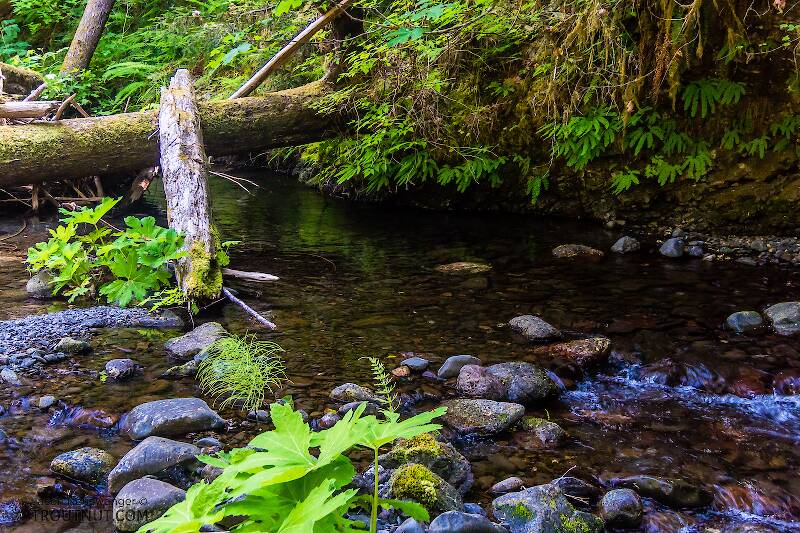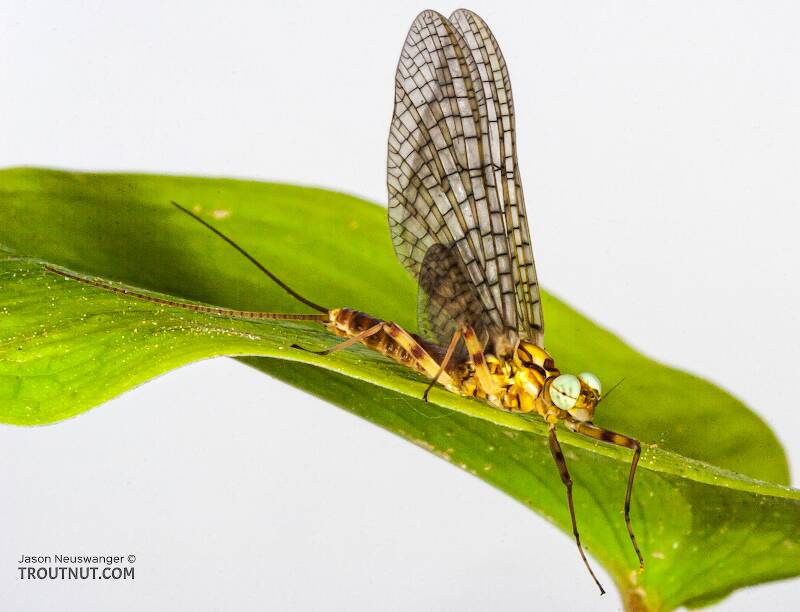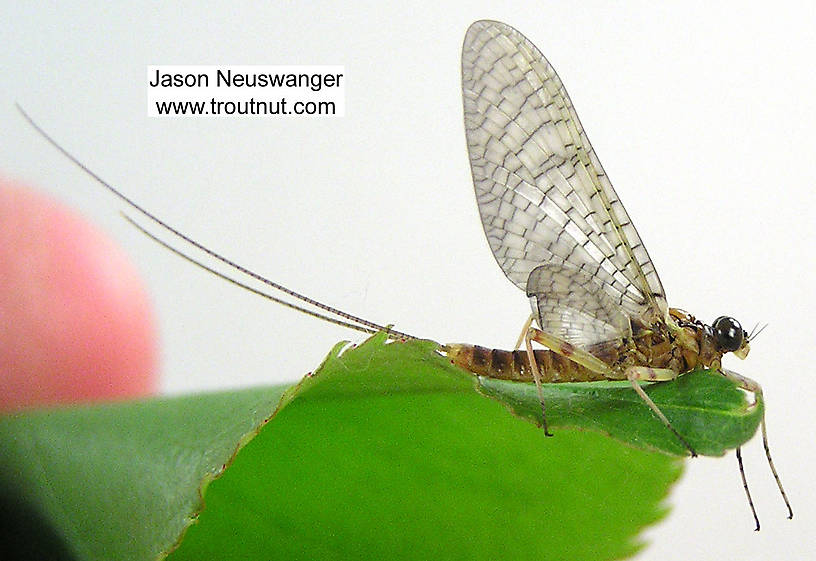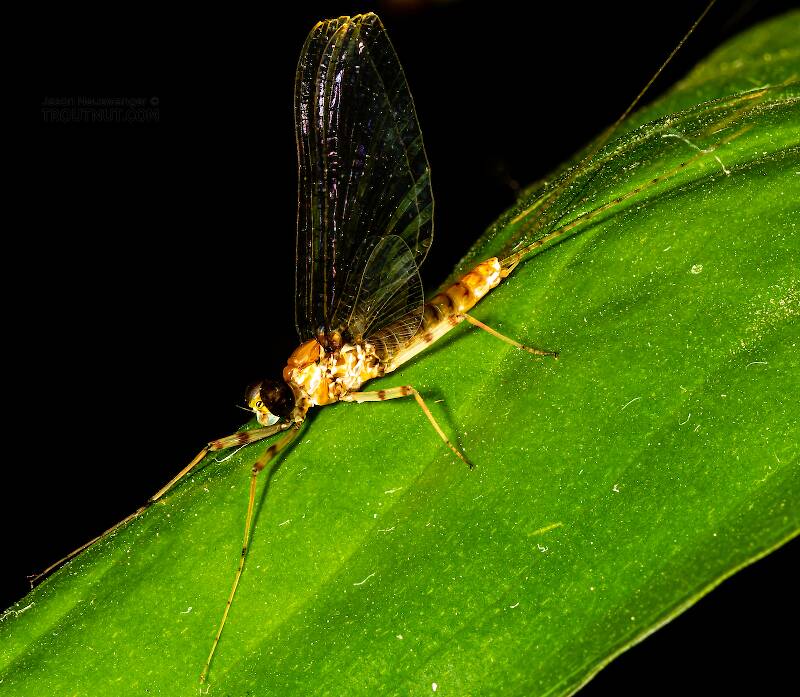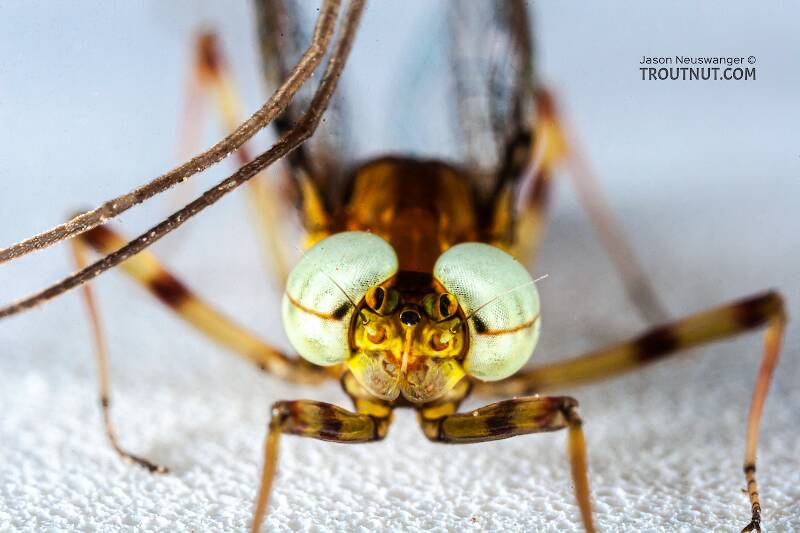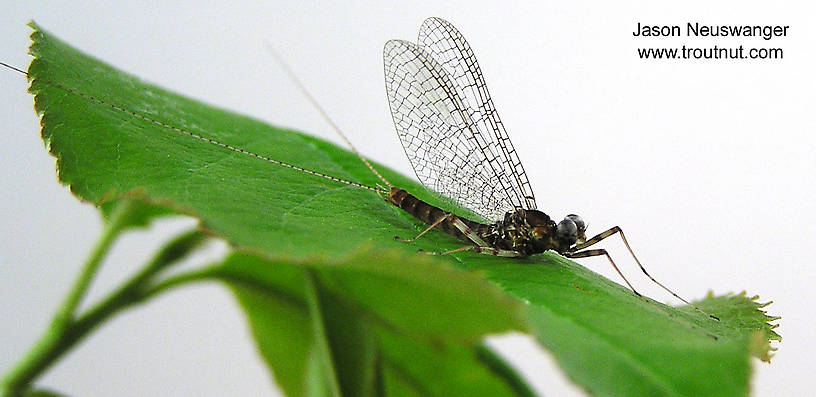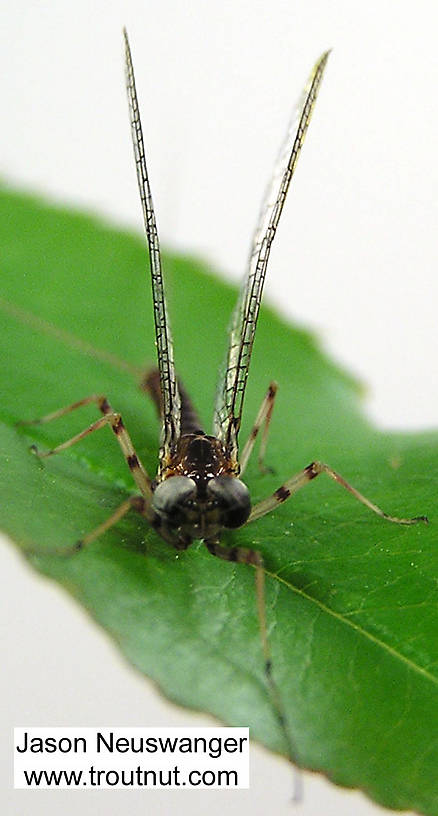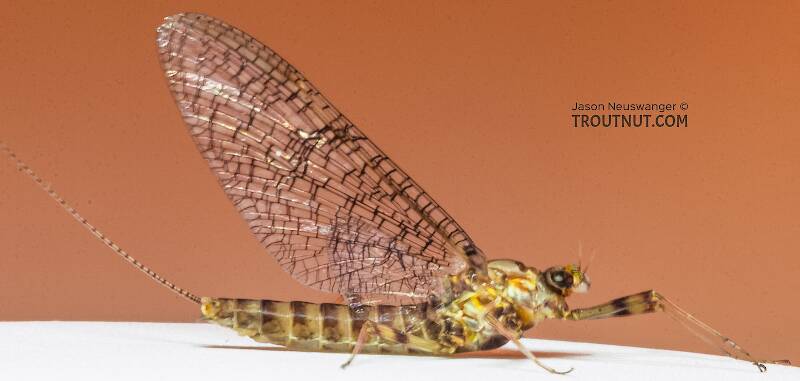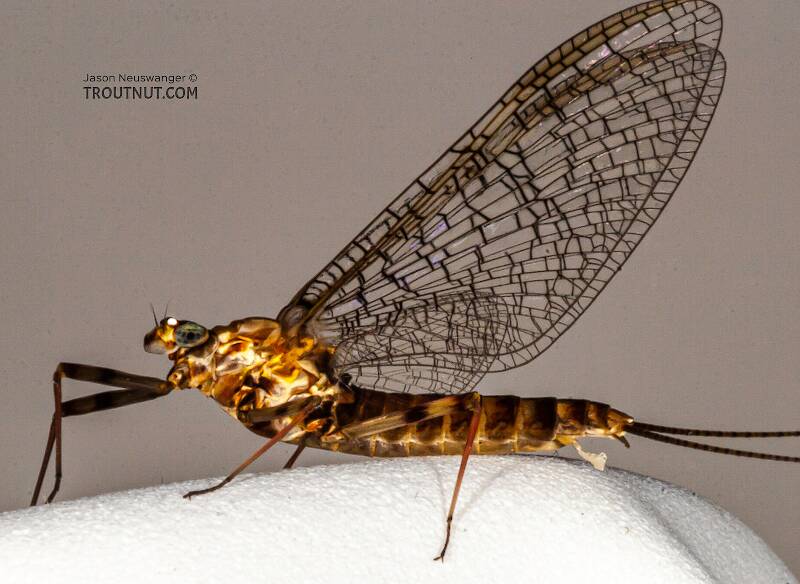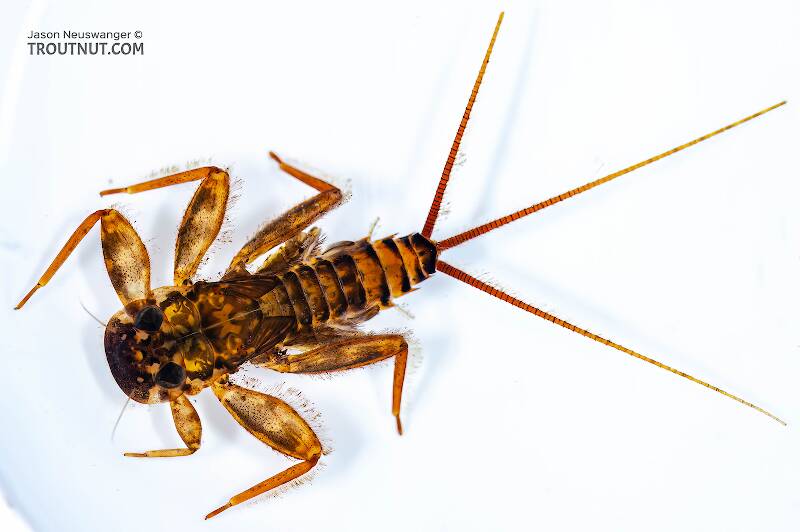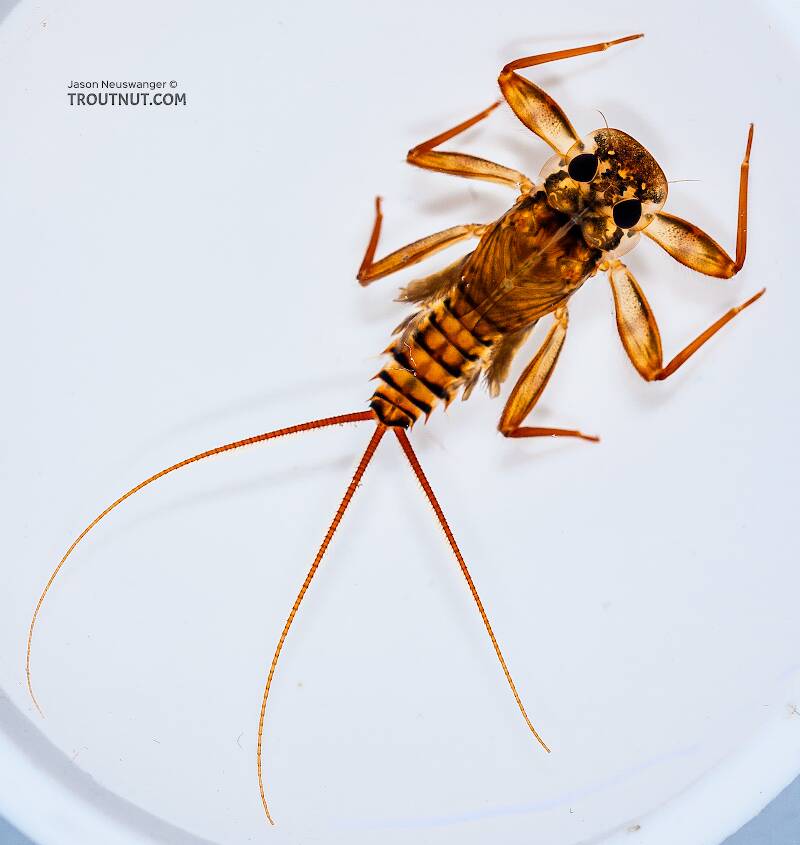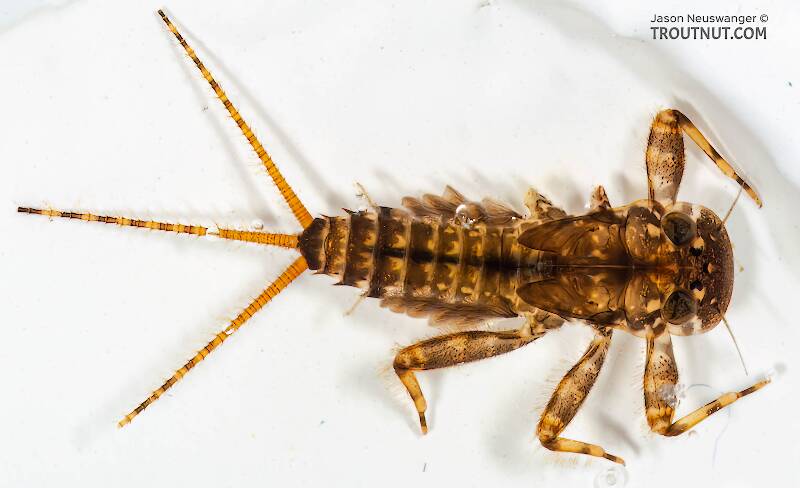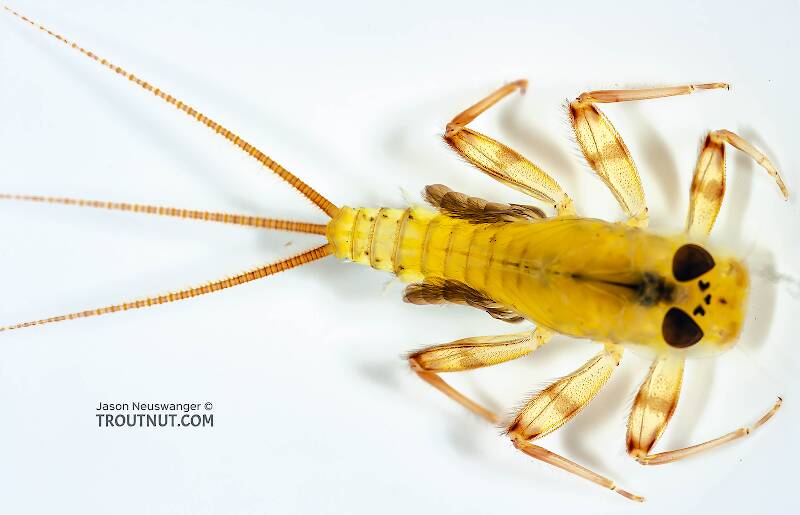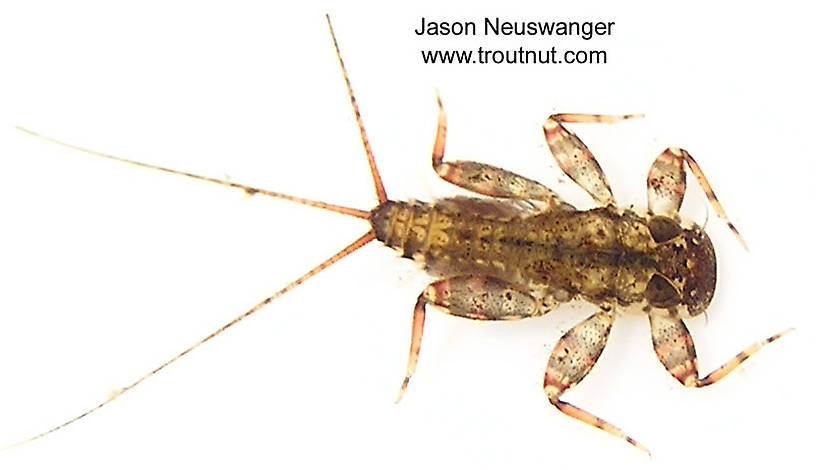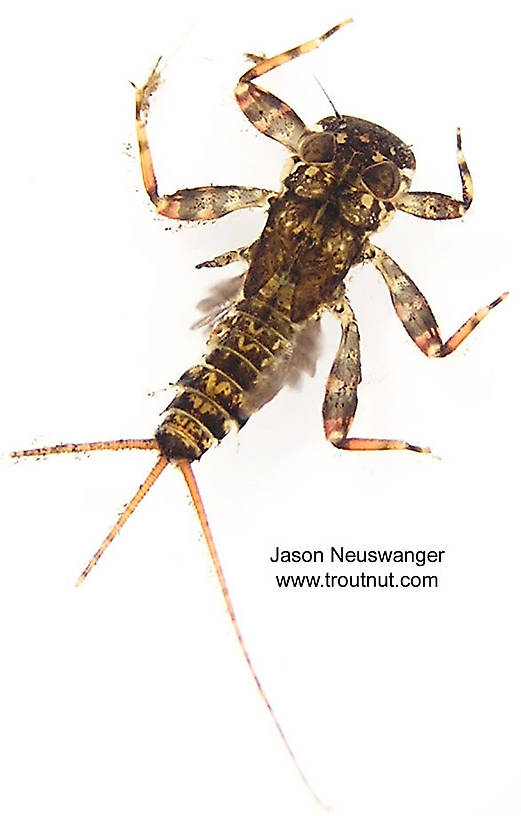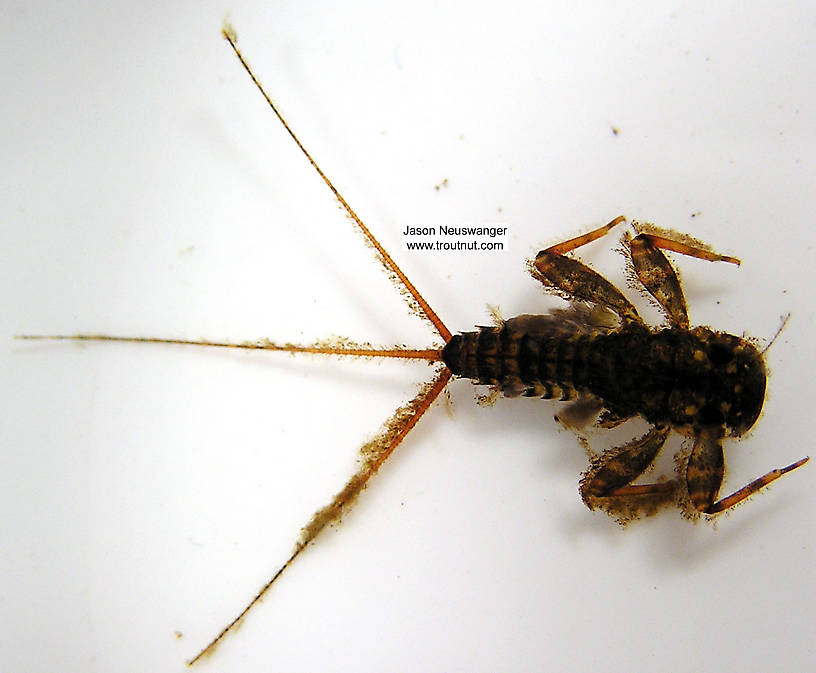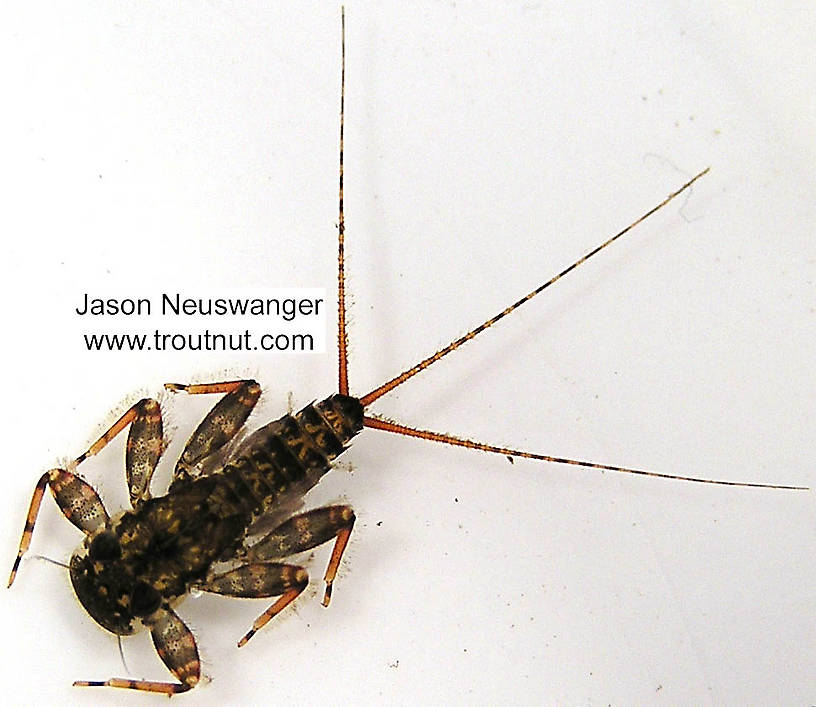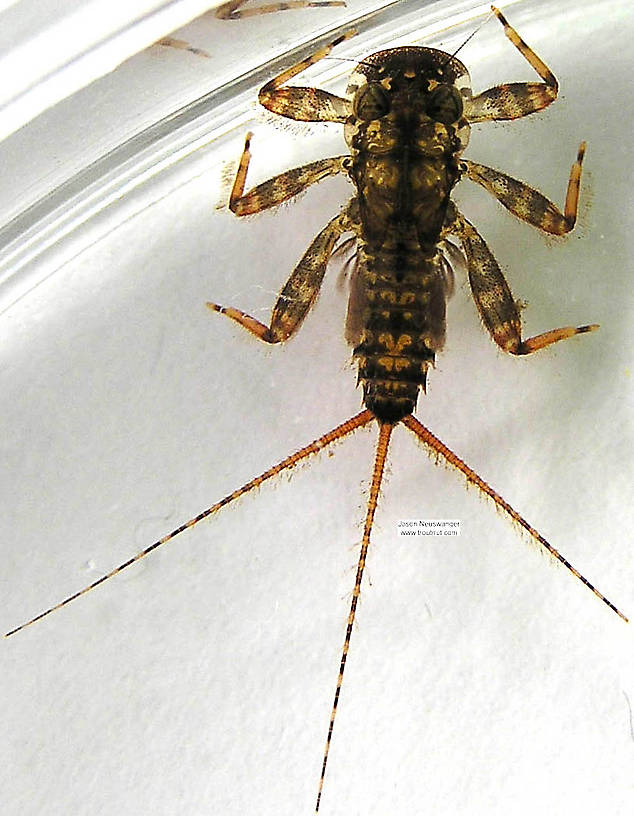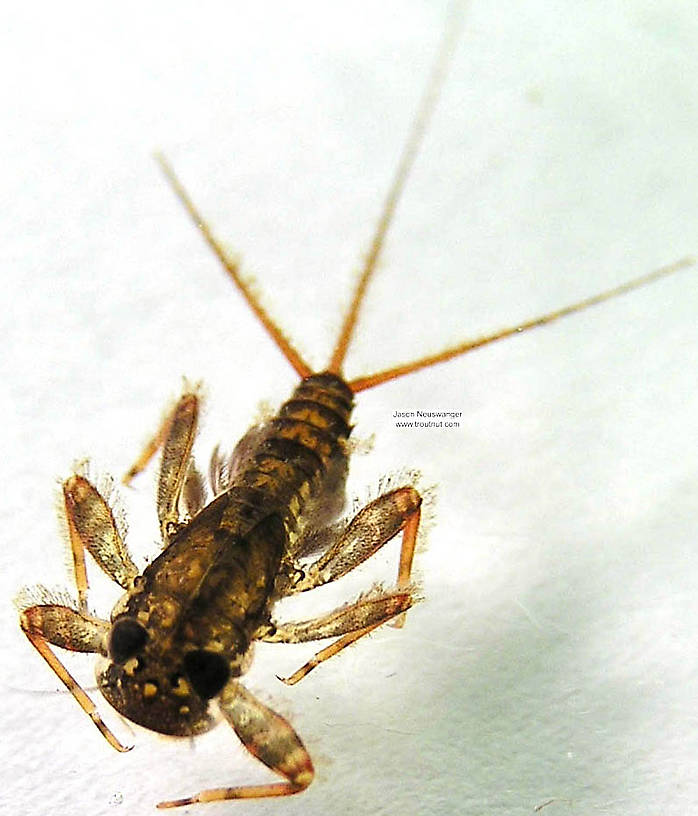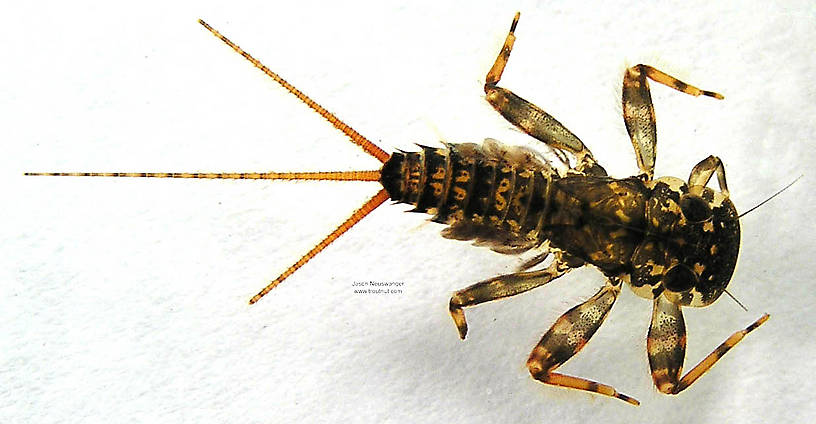
Hex Mayflies
Hexagenia limbata
The famous nocturnal Hex hatch of the Midwest (and a few other lucky locations) stirs to the surface mythically large brown trout that only touch streamers for the rest of the year.

Mayfly Species Stenonema vicarium (March Browns)
This species contains the two classic Eastern hatches formerly known as Stenonema vicarium and Stenonema fuscum, the "March Brown" and "Gray Fox." Entomologists have discovered that these mayflies belong to the same species, but they still display differences in appearance which the trout notice easily. Anglers should be prepared to imitate both types.
Where & when
This hatch begins in Pennsylvania and the Catskills in the middle of May. It peaks there in late May and early June. Throughout the rest of June and early July the hatch moves into the Adirondacks, New England, and the Upper Midwest.The best action lasts from 1-3 weeks in most places. The traditional March Brown duns originally in the vicarium species are more common toward the beginning of the hatch, while the former-fuscom Gray Fox variety take over in the latter weeks.
In 37 records from GBIF, adults of this species have mostly been collected during June (54%), July (22%), and May (16%).
Species Range
Hatching behavior
March Browns take a long time (sometimes more than 30 seconds) to escape their shucks in the surface film, and then they ride the water for a long time and struggle through failed attempts to take flight. This hatch is exceptionally prone to producing cripples and stillborns.
These characteristics leave room for many types of flies: floating nymphs, emergers, low-riding duns, hackled duns, and cripple patterns all have their place.
Spinner behavior
Time of day: Late evening through dusk
In Hatches II, Caucci and Nastasi write that the females oviposit by making repeated runs at the surface, dipping their abdomens briefly and rising up for another run. This contradicts the behaviors listed in Mayflies of Michigan Trout Streams, in which the Leonards say the females may drop their eggs from the air or release them as they fall spent. Readers are invited to share their experiences in the comments and clarify the spinner behavior.
Nymph biology
Current speed: All speeds, but best in fast water
Substrate: Everything from boulders to weeds to leaf drift to silt
Environmental tolerance: Very tolerant of high temperature and slow water
Trout appear to be aware of this phenomenon, for their stomachs will often be crammed with as many as 100 to 200 immature nymphs a week before the hatches will begin for the season.
Stenonema vicarium Fly Fishing Tips
This hatch often occurs simulatenously with more concentrated species, and fish may be selective to those. Although March Browns provide good action throughout much of the day, you should not let them distract you from higher-density hatches of smaller flies like Ephemerella invaria which the fish might take selectively instead.Physical description
Most physical descriptions on Troutnut are direct or slightly edited quotes from the original scientific sources describing or updating the species, although there may be errors in copying them to this website. Such descriptions aren't always definitive, because species often turn out to be more variable than the original describers observed. In some cases, only a single specimen was described! However, they are useful starting points.
Male Spinner
Wing length: 13-16 mm
A large species allied to S. fuscum (now a synonym of Stenonema vicarium) and S. rivulicolum (now a synonym of Stenonema vicarium); abdominal tergites largely dark red-brown: dark lateral patches on basal and middle sternites.
Eyes large. Head reddish brown, frons paler; purplish streak on each side of median carina; small dark spot at lower corner of eye; red-brown shading on vertex around bases of ocelli, darker shading posteriorly; two darker oblique submedian streaks. Thorax reddish brown. Pronotum shaded with purplish black; purplish streak on prothorax extending down on to fore coxa. Mesonotum with yellowish tinge; tip of scutellum reddish yellow, four small yellow spots anterior to it. A yellowish area anterior to wing root; yellowish intersegmental areas on pleura; purplish black markings around bases of legs and below wing roots. Purplish marks above and laterad of middle and hind coxae; coxae shaded with blackish. Mesosternum rather dark brown. Fore femur yellowish brown, with wide and conspicuous reddish purple median and apical bands. Middle and hind femora yellowish; bands as in fore femur, but more reddish. All tibiae distinctly reddish; deeper in color basally, paler apically. Fore tarsus yellowish brown with smoky tinge; middle and hind tarsi yellowish red. Basal joint of fore tarsus quite short; less than 1/3 but slightly more than 1/4 of second. Wings hyaline. Longitudinal veins yellowish brown, cross veins purplish brown, much heavier than longitudinals. Cross veins somewhat crowded at bulla; usually 2 or 3 in costal and subcostal spaces, 3 or 4 in radial space; some in costal margin and disc are narrowly dark-margined. Veins in anal regions of both wings finer, somewhat paler. Our specimens (determined by Dr. McDunnough) show no reddish stigmatic stain. Walker's description calls for the “fore border pale brown for one-third of the length from the tip.” Dr. McDunnough states that, as compared with S. fuscum, there is “a decidedly ruddier tinge” in this area. Hind wing not dark-tinged at apex or on outer margin.
Abdominal tergites 1-8 largely occupied by a wide dark reddish to purplish brown band, leaving only a narrow and irregular anterior margin, an oval area near spiracle, and submedian streaks from anterior margin, paler yellowish brown. A wide middorsal geminate streak, and dorsal portion of posterior margin of each, blackish brown. Tergites 9 and 10 largely reddish yellow, median streak faint; little or no dark shading. Sternites creamy yellowish; basal and middle ones with conspicuous purplish brown lateral patches, based on posterior margin; from each, triangular dark area extends forward to about the middle of the segment. On apical sternites, these areas faint or wanting. Genitalia much as in Stenonema pudicum; distinctly I-shaped. Tails usually rather deep olive brown; joinings deep reddish to purplish brown, alternate joinings wider. See figures of nymph and imago on PI. 1.
This species is larger than fuscum or rivulicolum, and has a relatively shorter basal fore tarsal joint. The dark ventral markings are much more extensive than in the latter, while fuscum is immaculate ventrally, the red tibiae seem distinctive.
Described as Stenonema fuscum
Body length 10 mm, wing length 13 mm
A species of the Stenonema vicarium group; no crowding of cross veins at bulla; stigmatic area amber, no red stain; abdominal tergites 1-7 normally brown, little contrast with darker posterior bands.
Eyes large; pearly grey in living insect. Epistoma of head pale smoky hyaline; smoky brown streaks on each side of carina; pale yellowish anterior to ocelli; bases of antennae pale smoky, ruddy basal rings. Vertex rather bright brown, yellowish shading behind lateral ocellus. Prothorax largely smoky. Mesonotum normally deep brown; on rear half of scutellum and in depression anterior to scutellum, whitish shading. Mesonotum sometimes much paler and whitish areas more extensive; in others, color is darker and little pale shading remains. Metanotum largely deep brown; anterior projection paler. Anterior to wing roots a reddish streak is split by a pale line. Pleura and sternum largely clouded with brownish; an oblique yellowish streak from fore wing root to base of fore leg, similar one at root of hind wing. All coxae smoky brown, streaked laterally and at base with blackish. Legs light amber; fore femora suffused with smoky; median and apical purple red bands on all femora; all tarsal joinings blackish, also claws. Basal joint of fore tarsus usually slightly more than one-third the length of second. Wings hyaline; costa, subcosta and radius smoky amber, other longitudinals blackish; cross veins rather fine, blackish; no crowding of veins at bulla. Stigmatic area slightly suffused with amber, but no reddish stain.
Abdominal tergites normally appear an uncontrasted brown; the dull smoky amber of each segment extending into forward-projecting indistinct streaks (like inverted question marks) from the deeper brown posterior margin, so that there is no sharp line of demarcation between the two. Dark streak on mid-dorsal line. Dark posterior border occupies about 1/3 of the tergite. In pale specimens, a tendency to a rather more banded appearance; in dark forms, whole area may appear dark brown. Tergites 8-10 opaque; suffused with rather bright brown; lateral edges of 9 and 10, sometimes of 8 also, distinctly bordered with alabaster white. Sternites dull pale smoky amber; immaculate; apical sternites more yellowish. In dark specimens, traces of brown triangular shading on each side of median line. Forceps and tails very pale smoky amber; tail joinings narrowly brown. Genitalia quite similar to those of pulchellum.
This species is closely allied to S. rivulicolum (now a synonym of S. vicarium); distinguished from that species by the lack of contrast between ground color and margin of anterior tergites, presence of pale lateral margin on tergites 8-10, absence of brown patches in postero-lateral angles of sternites, absence of reddish stain in stigmatic area.
Described as S. rivulicolum
Body length 10; wing length 13
A member of the Stenonema vicarium group; slight crowding of cross veins at bulla; reddish stigmatic stain; pale and dark areas of tergites distinct.
Eyes of living insect pale grey with greenish tinge; smaller than in S. fuscum (now a synonym of S. vicarium). Anterior portion of head very similar to fuscum; vertex deeper brown, intensified behind median ocellus and at middle of posterior margin. Mesonotum deep brown; pale areas around scutellum less distinct than in fuscum; posterior margin black tinged. Metanotum deep brown. Pleura deeper brown; reddish anterior area as in fuscum, but pale streaks at bases of legs less distinct, deeper ochreous. Blackish shading above base of middle coxa, also tinges of red in this region. Legs much as in fuscum, but with black patches at bases of all legs; black streaks on coxae broader; femoral bands darker in color, deep purple to purplish brown, and noticeably wider. Basal fore tarsal joint somewhat longer, almost half the length of the second. Wings hyaline; a distinct reddish stain in stigmatic area; cross veins distinctly thicker and slightly margined with diffuse brownish in costal space; tendency for cross veins at bulla to be somewhat crowded.
Abdominal tergites much as in fuscum, but posterior borders wider, half the width of segment anteriorly, deep purplish brown; anterior margin of this band sharply defined, not diffuse as in fuscum. Pale areas light amber, less smoky than in that species. A longitudinal median band on tergites 2-9, purple brown, wider than in fuscum; widened toward posterior margin on each segment. Segments 8-10 opaque, shaded with light brown; lateral margins paler brown, but not distinctly white as in fuscum Sternites 1-7 light yellowish, with small brown patches in postero-lateral angles of at least the anterior segments; sternites 8 and 9 shaded with light brown. Forceps pale smoky; genitalia as in fuscum. Tails smoky, darker at joinings.
Specimens of the Mayfly Species Stenonema vicarium
2 Male Duns
1 Female Dun
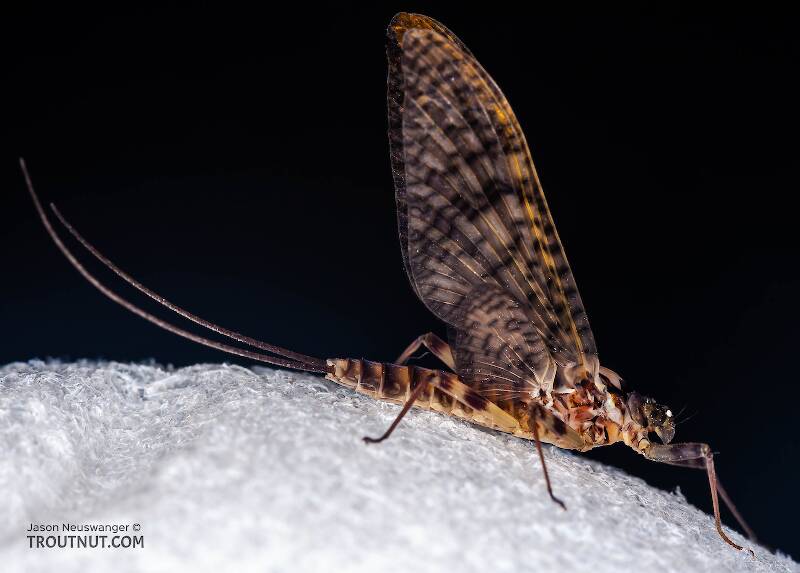
4 Male Spinners
2 Female Spinners
11 Nymphs
Discussions of Stenonema vicarium
Start a Discussion of Stenonema vicarium
References
- Arbona, Fred Jr. 1989. Mayflies, the Angler, and the Trout. Nick Lyons Books.
- Caucci, Al and Nastasi, Bob. 2004. Hatches II. The Lyons Press.
- Fauceglia, Ted. 2005. Mayflies . Stackpole Books.
- Knopp, Malcolm and Robert Cormier. 1997. Mayflies: An Angler's Study of Trout Water Ephemeroptera . The Lyons Press.
- Leonard, Justin W. and Fannie A. Leonard. 1962. Mayflies of Michigan Trout Streams. Cranbrook Institute of Science.
- Needham, James G., Jay R. Traver, and Yin-Chi Hsu. 1935. The Biology of Mayflies. Comstock Publishing Company, Inc.
- Schwiebert, Ernest G. 1955. Matching the Hatch. MacMillan Publishing Company.
- Swisher, Doug and Carl Richards. 2000. Selective Trout. The Lyons Press.
Mayfly Species Stenonema vicarium (March Browns)
Species Range
Common Names
Resources
- NatureServe
- Integrated Taxonomic Information System
- Global Biodiversity Information Facility
- Described by Walker (1853)

